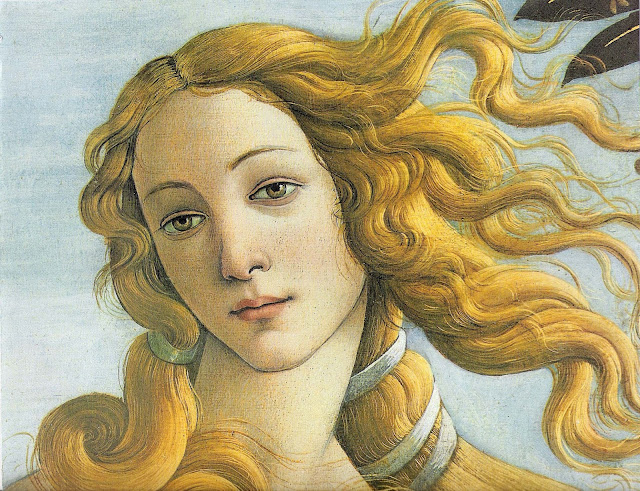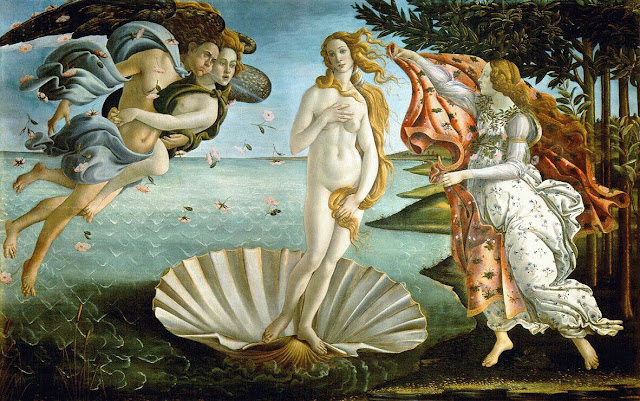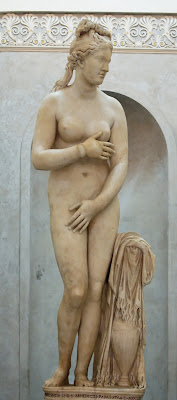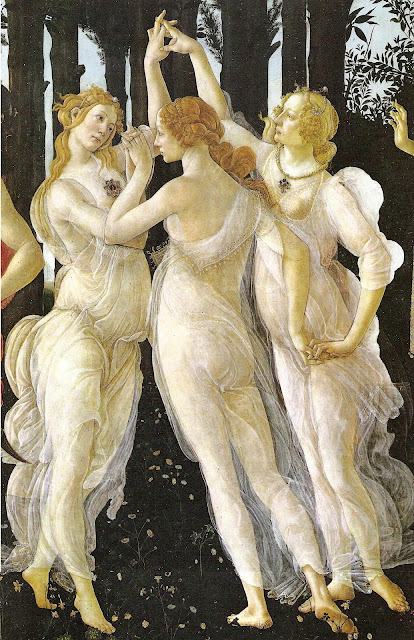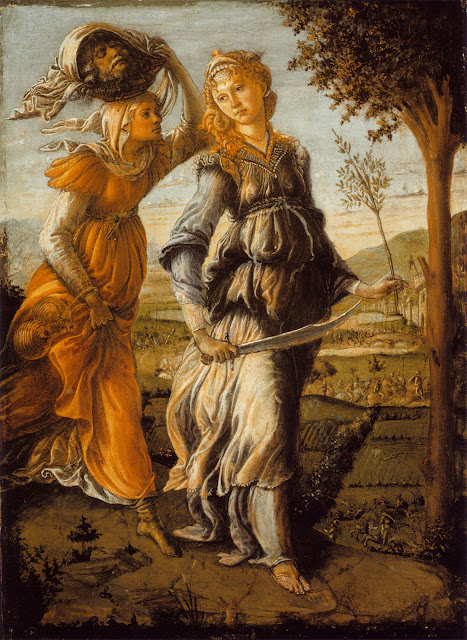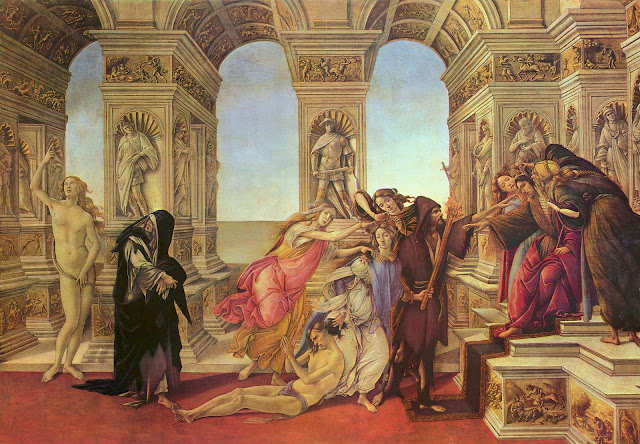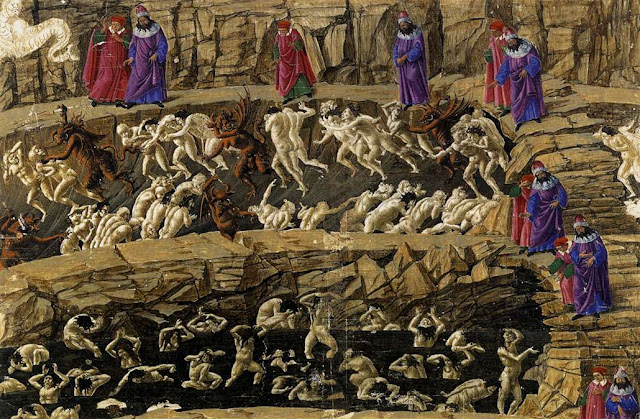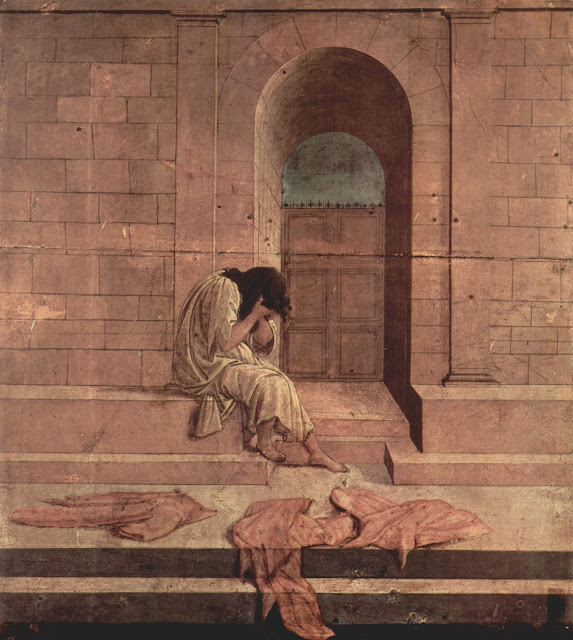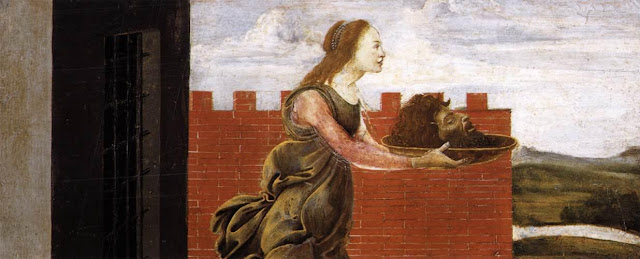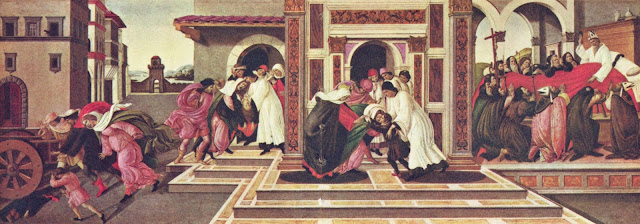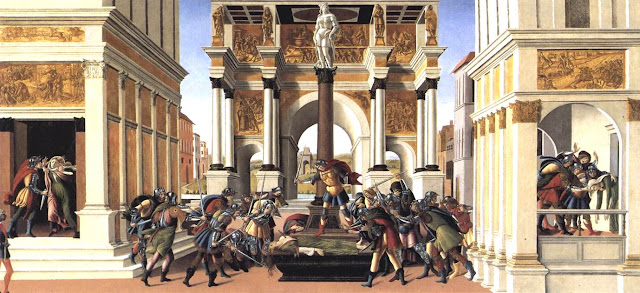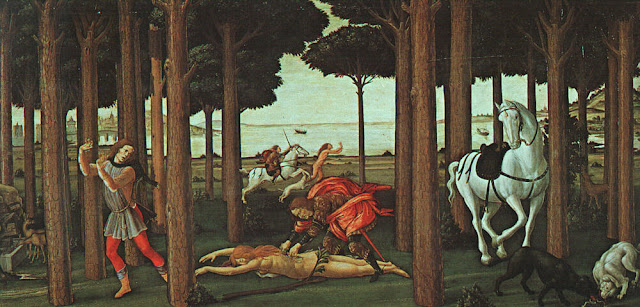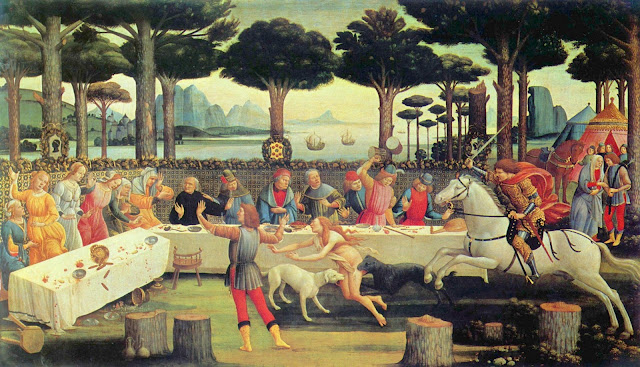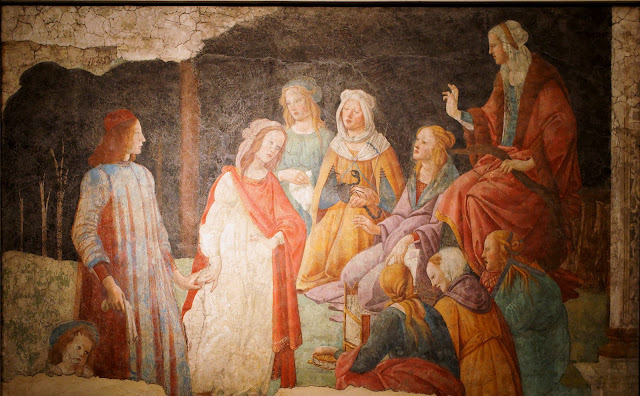Much Ado About Sandro Botticelli
http://phistars.blogspot.com/2012/05/much-ado-about-sandro-botticelli.html
Much Ado About Sandro Botticelli (1445- 1510)
Well, Sandro Botticelli is an early Renaissance artist. During his time, he was among the first to move away completely from Gothic. His background and figures still carry a bit of the stylized gothic style. Over all, he attempted to mimic nature to the best of his abilities. During this time period, a return to the Greek meant a resurfacing of human idealism. Now being a human is all that matter... Still, the church continued to call the shots in this Greek world. However, depictions of pagan Gods was no longer a taboo. With a rise of kingship and banking, there came a demand for new types of artworks (not related to the Catholic church).
The Medici themselves (now in control of the Vatican, the crown and the banking system of Italy) started investing on painters to aggrandize their prestige. Thus, commissions ranged from Kingly portrait to private commissions. Paintings in the houses of bankers had mostly Greek philosophical themes. You know, rich people could afford to study humanities and Plato. So, they developed a healthy liking for Greek Female nudes... hehehehe!!! Well, that's the Medici for you. When you control the Catholic church, you can get away with a lot of weird things. Controlling the Papacy back then was a lucrative busyness. Anyhow, it was in this world that Botticelli put his brushes to good use.
Well, lets just get this show on the road. The first lil number is called Minerva and the Centaur (1480-82). Minerva or is the Goddess of Justice. The Centaur is a mythological monster. The fusion of a man and beast. This painting shows Botticelli's perspective on woman's power over men. Minerva represents a woman of virtue and wisdom. She is holding the beast at bay. The Centaur here is a man ruled by carnal desires. A fool as such can be tamed by a wise lady.
Visually, Minerva has the laurel, crown of Victory. The halberd (the weird ax spear) represents virtue. Lastly, those three red diamonds (two in her breast and one in the belly) are the symbol of the Medici. This one in specific was inside the bedchamber of the Medici Bride. This one was a private commission (unrelated to the kings and the church). Usually, the patrons gave a general descriptions of what they desired. Thus, the Medici bride wanted to show in this painting how she tamed the lustful nature of her husband. Pretty cool!! Well back then, it was fashionable for rich ladies to be just as educated as men (even more so,sometimes). It makes sense thus, that the Medici bride wanted to appear educated.
The figures are like idealized like Greek Statues. The background is also idealized. It is meant to show nature at its best. One sees behind Minerva, a calm sea. The centaur is being pushed against the ruined Greek Temple columns. The centaur is the old lustful man, cloaked in Greek Humanism. Minerva is the Medici lady (honorable, strong, sophisticated). Its an interesting contrast between the two. Well, I think that is everything worth mentioning about this painting. Boy, that was a long intro... In any case, this wonderful painting deserves 5 star rating.
Above is a closeup of the face of Venus. This one is The Birth of Venus (1486). It is not certain who commissioned " The Birth of Venus". However, like Primavera, the Venus painting ended up in a Medici townhouse. There are some rumors going about that Venus was Simonetta Vespucci. She was a married noble woman that Botticelli had a crush on. When he died, he asked to be buried at her feet (i.e in front of her grave). Others go as far as to suggest, that she posed nude for Botticelli (however, that is unlikely).
There where others who used accused Botticelli of being gay. However, being gay was a fav pastime of noblemen. Since noble women where seriously off limit (chastity being mandatory for women, but not for men), noblemen started sleeping with each other (they did not sleep with their maids because they did not want to produce bastards). It got to such a point that the Vatican started subsidizing brothels. Heheheh,now that was a real bummer.
Above, we see the most beautiful Greek Goddess. According to Plato, physical beauty helped one better understand spiritual beauty. Thus, by gazing at her one could gaze upon the beauty of the creator. Thus, in a bizarre fashion this painting has biblical references (to divine love). The figures themselves look flat. During Botticelli's time, there started circulating texts describing an infamous Venus rising from the sea painting. Scholars believe that Botticelli was trying to recreate the Venus from the writtings. The painting does look a lot like a colored relief. The pose is taken from the Modest Venus.
Another way to look at the painting, is to see Venus as a proto Eve. This was Eve before she tasted the apple. Well next to her is The Zephyrus and his lover Flora. Together they blow wind and some spring flowers as they move Venus toward the shore. Horae (Goddess of seasons) holds out a mantle to cover her. Mythological wise, Venus was said to have been born full grown out of the sea water foam.The water waves are a bit stylized. In any case, this painting deserves 5 star rating.
Above is a detail of Primavera.Here we see the Three Graces dancing.What I like about this one is how Botticelli made the dresses of the Graces. They actually look transparent. This is Botticelli's own original painting style. Its interesting their serious expression. This is because restrained emotions was fashionable back then. Thus, all of the Graces behavior inspires grace. The Graces themselves have long hair, richly adorned. One of the blonde graces sports a pearl necklace with a star jewel at the end. Pearls here mean flawless feminine beauty. I think that is all worth mentioning on the Graces.
Next to the Graces, there is Mercury reaching for a fruit. In this scene, he represents abundance (of flowers ect) . Behind him, spring or Primavera is blossoming. Toward the far right, Zephyrus and Chloris are playing around. When Chloris speaks flowers sprout. Zephyrus' winds is making Chloris spill out flowers from her mouth. She was kidnapped and married to Zephyrus. Next to the wind, there is (the second manifestation of Chloris)Flora, the Goddess of Flower (makes sense considering all the flowers she has about herself). In the center, there is Venus, Goddess of Love. Above her, Cupid has his bow drawn. During those days, Venus was seen as the pagan equivalent of the Virgin Mary because she ruled both earthly and heavenly love. Her pose and demeanor contrast with the classical Greek behavior of all the other figures. She is the central figure. Behind her, the forest opens as if she had a halo about her. It think that is everything worth mentioning. 5 stars.
This painting is called The return of Judith to Bethulia (1472). Well,by now you guys are familiar with Judith. I am not going to repeat myself (for more info read the Gentileschi blog). In this one, Judith is returning to Jerusalem with the head of Holofernes. In the background, you can see the opposing armies fighting. The landscape here has a well defined Vanishing Point (this is new development). Behind something that Botticelli calls a tree, you can see the walls of Jerusalem. Both are almost at the secret entrance. Well, that is a historical landscape. Nothing too far out there. The clothing of the ladies follow the ancient Greek fashion. The sword is actually Persian. Again, Botticelli paints his women strong and independent. Then again, no painter painted for the fun of it those days. It seems that the church patron wanted his Judith to look as thus. In any case, this lil number deserves 5 star rating.
This weird painting is called "The Calumny of Apelles" . During these days, it became common for painters to reproduce ancient paintings based on old record descriptions. The Calumny obviously did not survive. However, the descriptions still survived. Anyhow, lets start with the king. The king has donkey ears. This means that he is a fool. The maidens next to the king represent Ignorance (the lady with the wild hair) and Suspicion (the barefooted maiden in green). The maiden in blue is Slander. She carries a torch (like the Furies) and her victim by the hair. The ugly man conducting Slander represents Envy.
He is bringing Slander (false accusations) upon the young man. Slander is being adorned by Fraud (the pretty maiden in pink) and Conspiracy (the one coming from behind). The ugly man has accused the boy of Treason against the king. Such accusations would mean death to the boy. The young man implores forgiveness to Repentance (the old lady dressed in black). She is turning her gaze from the scene and looking at Truth (the pretty nude lady pointing toward the heavens) for guidance. You know, the position of the young man's legs alludes to the cruxified Christ. Punishment for treason in the Roman world meant crucifixion.
Basically, Apelles was accused of leading a revolt. Then, a friend revealed the truth to the King Ptolomey. The Envious guy was sold to slavery. This painting relates to Botticelli's life because they had accused him during those days of committing sodomy. This would have utterly ruin his reputation and his honor. With his honor stained, Botticelli would have not been able to receive any more commissions from the Medici. What's interesting is that only the passive partner was ever accused of sodomy. Ok, moving along.Since Botticelli did not know what the background looked like he just painted something that looked Roman. He painted a lot of reliefs (similar to the Ara Pacis in Rome) and some Saint sculptures. The columns' forms are similar to the column arrangement of the Colosseum. The statues per column are a carry over from Gothic sculpture. The red carpet leading up to the throne was still being used among the aristocracy of Europe. I think that is everything worth mentioning of this 5 star worthy painting.
This maiden is called Fortitude (1470). She is one of the seven Virtues. Botticelli was competing with another man for the commission. He had to satisfy himself with just Fortitude.If you notice, this painting has a lot of fine (small) detail. He really was trying to outdo the other guy that got the rest of the six virtues. Anyhow, the set were meant for a public court. This was his big chance to get exposure (you know, the rich and poor visit such courts all the time). This painting started off Botticelli's painting career. I can see why. It is a lovely painting. Look at her armor and her scepter. She really does look like the allegory of Fortitude. In any case, this lovely painting deserves 5 star rating.
This painting is called Inferno (as in Dante's Inferno). Anyhow, this one is part of a huge series of paintings (this one was the only one that was completed) featuring the entire Divine Comedy. He wanted to illustrate every canto (or stanza). Anyhow, here the poet Virgil is guiding Dante through all the nine levels of hell. Virgil was in hell because he did not accept Christ (he shares this level with all the unbaptized babies. However, recently the Pope got rid of the limbo concept. He thought it was too cruel and unusual. Plus, Christ said that all who harmed children deserve to die). So no more limbo. In any case, this lil number deserves 5 star rating.
The next one is called "The Outcast". Basically, we see a sobbing woman. She has just been thrown out of her home. Around her, we see her clothing scattered. Her pose is in the Greek manner of expressing mourning. The house looks roman. This is Botticelli's vision of utter grief. There is no one helping this maiden. In any case, this painting deserves 5 star rating.
This painting is called The Story of Nastagio Degli Onesti (1483). Around Botticelli's time, a popular play ,The Decameron by Boccaccio, was going around. The story goes that a knight had asked a maiden to marry him. She refused and then gave in in the end. The knight then told her a story of another cruel maiden. She had refused marry. Her lover then hunted her down, skinned her and fed her intestines to the dogs. This is the end of that story. In this scene, the knight has finally married her beloved. I think he was threatening his lover. Either way, here is a happy banquet. The interior looks like roman Triumphant arches. In any case, this lil number deserves 5 star rating.
Above, is the start of the story. Here the maiden is being eaten by the dogs. Behind her you can see the berserk knight. You know, this was a wedding present from the father of the groom. A real bummer...Anyhow,this scene is taking place in the forest. The knight and his helpers are cornering the maiden. In any case, this one deserves 5 star rating.
This is a detail from "The Youth of Moses" (1482). These two maidens are speaking to Moses by the Well. If I remember correctly, one of these maidens will become Moses's bride. Both maidens are shepherds. Both are dressed like ancient Israelite. In any case, this painting deserves 5 star rating.
This painting is called "Salome with the Head of St. John the Baptist". Salome was the hottie who danced the dance of the seven veils for her step dad. She wanted to get John the Baptist head for her mother. Here Salome is bringing the head to her mother. She looks quite happy and eager to please her mother. The surroundings is a bit medieval. There seems to be a water ditch around the castle. In any case, this painting deserves 5 star rating.
This painting is called " The Road to Calvary". Well, Calvary was the place where Jesus was cruxified. Here a Hermit is pulling a rope that will lead him to the site. Behind him, a knight with a baculo (power stick... really, it is a power stick) is urging him on. This seems more like a pilgrimage to the site of Jesus' death. The armor of the knight seems medieval. In any case, this painting of Botticelli deserves 5 star rating.
Above, Judith is getting out of the tent with the head of Holofernes. She looks very cool gazing at the head of her victim. During these days, they started raising the status of women (to promote their honor). Plus, the subject matter of the female worthies became really popular. This theme focused on the depiction of honorable women from the Bible. Following this trend, Botticelli painting this honorable widow that saved Israel. In any case, this lovely painting deserves 5 star rating.
I am not too certain about the title of this painting. It basically shows three scenes of the life of a saint. On the right, he is about to drop dead. In the center, he is healing some random people. On the left, I think he is bringing someone to life. The scenery is quite Italian. It must be one of their patron Saints. In any case, this one deserves 5 star rating.
The next painting is called " The Discovery of the Body of Holofernes" . Here the guards are shocked to see their boss man without a head. Most of the guys are dressed like ancient Canaanites. There is one knight, in golden armor, whose design is medieval. You know, is that horse inside the tent? His pose is similar to horse statues of those that died in the war. The headless body looks pumped up and idealized. In any case, this painting deserves 5 star rating.
The next painting is called "The Punishment of Korah, Dathan and Abiram "(1481). This is a scene from the Old Testament. Anyhow, those three guys had revolted against the leadership of Moses in the desert. God punished them by having the earth literary swallow them whole. On the right, Joshua is stopping the rebels. He is trying to keep them from getting at Moses. Some have broken through the ranks. In the center, they are attacking Aaron (he speaks on Moses behalf to the people). On the left, Moses is calling God to punish the rebels. Moses appears in all three scenes in the painting. He is the old man in green. On the left, you can literally see the earth opening up to slay Moses's enemies. I guess you can't blame the trio for rebelling against Moses. After all, 40 years in the desert is no picnic (even with a daily supply of Mana). Anyhow, this painting deserves 5 star rating.
This painting shows "The Story of Lucretia" (1504). On the left, while Lucretia's husband was away in the war this maiden is visited by the King's son. The son thus rapes this honorable lady. On the Right, Lucretia has just stabbed herself after telling her family members about the rape. In the center, around the grave of Lucretia her family members are taking revenge against the king. Brutus the man in the center is exhorting the crowd to rebel against the Roman king. Her death fueled the fire that started the ancient Roman republic. The scenes takes place inside a roman public forum. The entire scene is being watched by Athena, the Goddess of Justice. Anyhow, this lovely painting deserves 5 star rating.
This is the second scene of the story from the Decamaron. Here the maiden is being skinned by her lover. The dogs are being fed her intestines. Ew...this painting seems to portray the extremes of violence against women. Its not too uncommon for distraught lovers to murder those who reject them. Even, I think this was a bit too much. This one deserves 5 star rating.
The last one shows the same scene of the maiden hunted by dogs in the garden inhabited by the main characters from Decameron. The man in the center is starting the story of the ill fated lady. Cool, that narrator is literary bringing the story to life for his listeners. In any case, this painting deserves 5 star rating.
The next painting is called " The Story of Virginia " (1504). The story of this one really does suck. Its all about restoring woman's honor via death. This shows the moralism going about Rome during Botticelli's time. A woman was better off dead after being rape. That is a real bummer...its for this reason, that most women where secluded in their home. Basically, the scene on the scene of the left, Virginia accompanied by other women is raped by Tacitus. Tacitus did this on behalf of Caecus who wanted Virginia for himself.
He then takes her to court to be trail for adultery. The judge was none other than Caecus himself (this is the middle scene). During the trail, her husband and her father plead on her behalf. Obviously, this did not work. Caecus sentenced her to live the rest of her life as his slave. The father to preserve the family's honor slays her and flees on horseback (the scene on the right). As you can see, honor killing is not a new thing. It really is quite the depressing story. In any case, this sad painting deserves 5 star rating.
The next painting is called "The Triumph of Mordecai from the Story of Esther" (1480). Above Mordecai has just overheard a plot to slay the king. He is about to relate the information to his cousin, Esther. In any case, this painting deserves 5 stars.
The next one shows scenes from the early life of Moses. I already described the center scene of Moses as a shepherd. On the left, the women are taking their children to the slaughter. On the right, Moses slays an Egyptian who was accosting a Jewish slave. Works pretty well. In any case, this painting deserves 5 star rating.
The net painting shows "Three Scenes from the Life of Esther". On the left, Esther has just joined Xerxes harem. On the center, Esther faints at the sight of Xerxes. On the right, she is in Xerxes' room. The scene takes place in a Roman palace. All the characters are wearing ancient Roman robes. Just like regular biblical scenes. In any case, this painting deserves 5 stars.
The next painting is called "Venus and Mars". Here Mars lies exhausted after sleeping with Venus. He could not tame the lady. Judging by her pose, she is waiting for Mars to get his second breath. The moral of the story is that Love always conquers War. Anyhow, Venus is wearing a lovely white dress of the Italian Lady fashion. Mars' armor is a knight's armors. You can see his lance being carried off by some lil fauns. One is even trying to wake up Mars with a shell horn. As we all know, sea shells are a symbol of Venus. She is trying to rouse him to get back to work. This scene takes place in the forest. Most Greek romances took place in the forest. However, originally this took place in the marital bed she shared with her crippled husband, Vulcan. What a pity... In any case, this painting deserves 5 star rating.
The next one is a fresco of "Venus and the Graces Offering Gifts to a Young Girl" (1486). This fresco represents the kind of education that women receive when they come of age. The young girl is the only one dressed in Italian 15th century dress. Next to her is a lil Cupid. Well, frescoes was basically paint on wet plaster. This kept the paint on the walls indefinitely. I guess he did not use a good primer coat. Then again, the fresco technique was a new thing. Oh well, this fresco deserves 5 stars rating.
Here we see "Esther at the Palace Gate" (1480). She is listening to the news from her brother. She looks quite alarmed by her cousin's news. She has to inform the king of the plot to slay the king. Now, all she has to do is warn him to gain his favor. She looks lovely in her red dress. The palace really does look medieval. Works, just as well. 5 stars for this lovely paining of Botticelli.
Well, the last painting is called "Young Man Greeted by Seven Liberal Arts" (1490). This one goes in par with the young Lady's fresco painting. Here the young man is receiving education. All the seven maidens represent the schools of education popular during Renaissance time. All young men had to know all these liberal arts before marriage. Its all a real bummer. In any case, this fresco deserves 5 star rating. I hope that you liked this Botticelli blog even a lil bit. Tata, and good night.
.

